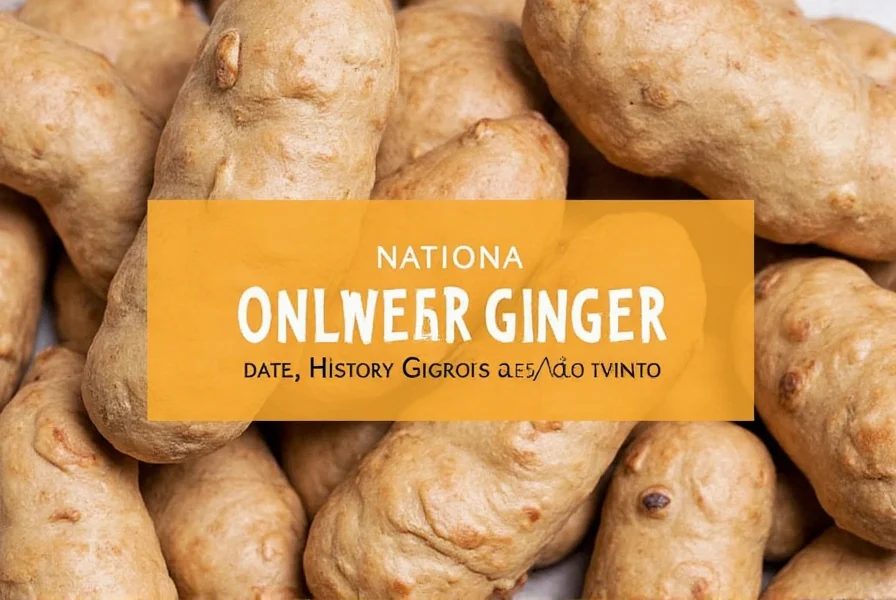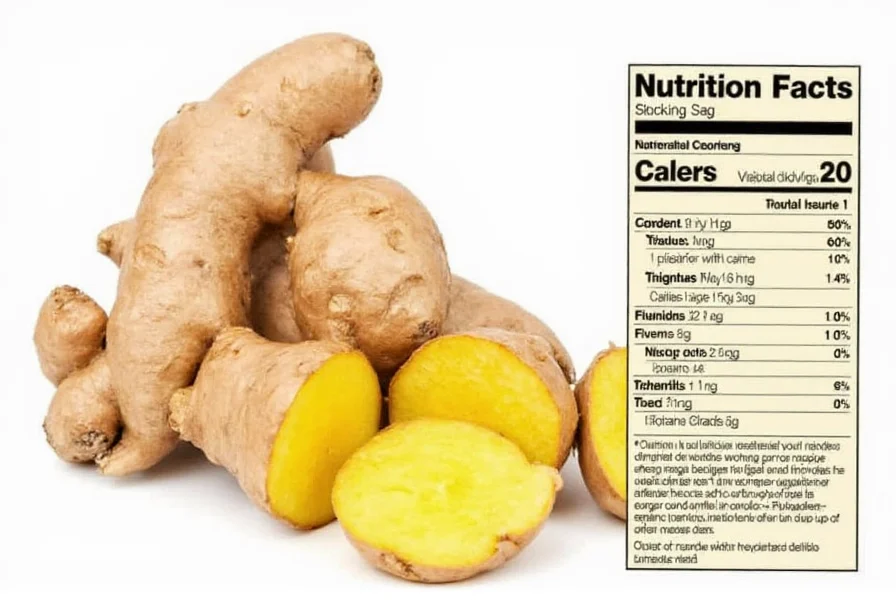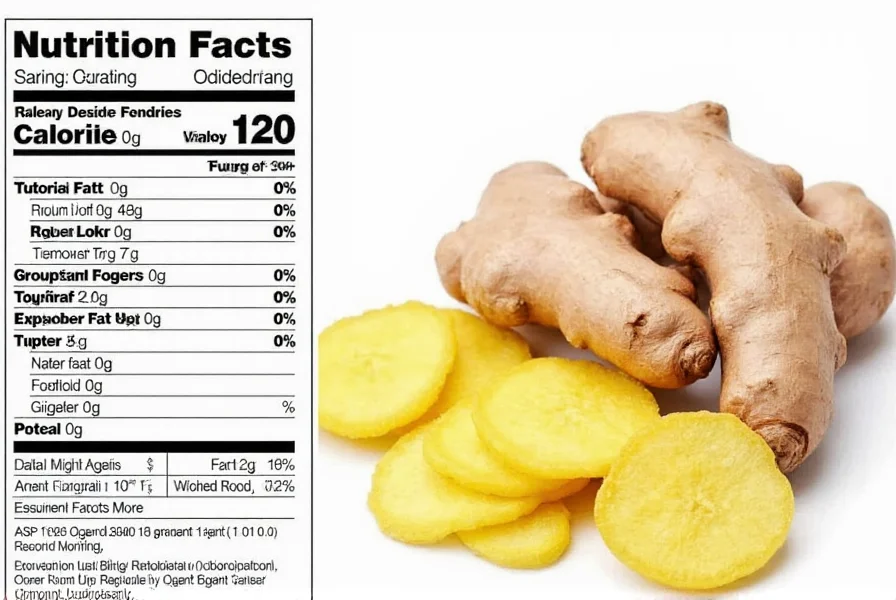Understanding the nutritional composition of ginger root helps health-conscious individuals make informed dietary choices. This versatile rhizome has been used for centuries in traditional medicine and culinary applications, but its specific nutritional profile often remains misunderstood. Scientific analysis reveals ginger's impressive micronutrient density despite its relatively low caloric content, making it valuable for those seeking natural health support without significant calorie impact.
Nutritional Composition of Ginger Root
Ginger root's nutritional value extends far beyond its distinctive flavor. While commonly consumed in smaller quantities than 100g, understanding its complete nutritional profile per standard measurement provides valuable context for dietary planning. The root contains a complex array of nutrients that work synergistically to support various bodily functions.
| Nutrient | Amount per 100g | % Daily Value* |
|---|---|---|
| Calories | 80 kcal | 4% |
| Total Fat | 1.7g | 2% |
| Saturated Fat | 0.2g | 1% |
| Carbohydrates | 17.8g | 6% |
| Dietary Fiber | 2.0g | 7% |
| Sugars | 1.7g | - |
| Protein | 2.0g | 4% |
| Vitamin C | 5mg | 6% |
| Vitamin B6 | 0.2mg | 12% |
| Magnesium | 43mg | 11% |
| Potassium | 415mg | 9% |
| Manganese | 0.2mg | 79% |
*Percent Daily Values are based on a 2,000 calorie diet. Individual needs may vary.
Key Bioactive Compounds in Ginger Root
Beyond standard macronutrients and vitamins, ginger contains several bioactive compounds that contribute significantly to its health properties. Gingerol, the primary active component, gives ginger its characteristic pungent flavor and accounts for many of its therapeutic effects. When ginger is dried or cooked, gingerol converts to shogaol, which has even more potent antioxidant properties.
Additional compounds include:
- Zingerone - Formed when ginger is cooked, contributes to ginger's aroma
- Paradols - Metabolites of shogaol with potential anticancer properties
- Terpenes - Contribute to ginger's distinctive fragrance

Health Benefits Supported by Ginger's Nutritional Profile
The specific combination of nutrients and bioactive compounds in ginger root nutrition facts explains its traditional and scientifically-supported health applications. Research indicates that regular consumption of ginger, even in moderate amounts, may support:
Digestive health: Ginger's compounds stimulate digestive enzymes and accelerate gastric emptying, which explains its traditional use for nausea relief. Studies show ginger root nutrition benefits include reducing symptoms of morning sickness, chemotherapy-induced nausea, and postoperative nausea.
Inflammation reduction: The gingerol content demonstrates significant anti-inflammatory effects by inhibiting pro-inflammatory cytokines. This makes ginger a valuable dietary component for those managing inflammatory conditions.
Antioxidant protection: With an ORAC (Oxygen Radical Absorbance Capacity) value of approximately 28,811 μmol TE/100g, ginger root provides substantial protection against oxidative stress, contributing to cellular health and potentially reducing chronic disease risk.
Practical Dietary Applications
Understanding ginger root nutrition information helps optimize its incorporation into daily meals. While the complete nutritional profile is measured per 100g, typical consumption ranges from 1-3 grams of fresh ginger daily for general health maintenance.
For maximum nutritional benefit:
- Use fresh ginger rather than powdered when possible, as it contains higher levels of gingerol
- Grate or mince ginger to increase surface area and enhance nutrient release
- Combine with black pepper to increase absorption of beneficial compounds
- Add to warm (not boiling) liquids to preserve heat-sensitive compounds
When comparing fresh ginger versus dried ginger nutrition facts, note that drying concentrates certain compounds while reducing others. Dried ginger contains higher concentrations of shogaol but lower moisture content, making direct comparisons challenging without adjusting for weight differences.

Considerations for Specific Populations
While ginger root nutrition data shows it's generally safe for most people, certain populations should moderate consumption. Those taking blood-thinning medications should consult healthcare providers before consuming large amounts, as ginger's compounds may interact with anticoagulant effects.
Pregnant women often seek information about ginger root nutrition during pregnancy. Research suggests moderate consumption (up to 1g daily) is generally safe and may help with morning sickness, but higher doses should be avoided without medical supervision.
The manganese content in ginger, while beneficial for bone health and metabolism, requires awareness for those with certain liver conditions, as impaired manganese excretion could potentially occur with excessive consumption.
Frequently Asked Questions
How much ginger should I consume daily for health benefits?
Research suggests 1-3 grams of fresh ginger root daily provides measurable health benefits without risk of adverse effects for most adults. This equals approximately 1/2 to 1.5 teaspoons of grated ginger. Higher therapeutic doses up to 4 grams daily have been studied for specific conditions like nausea relief, but should be discussed with a healthcare provider.
Does cooking ginger affect its nutritional value?
Yes, cooking transforms ginger's bioactive compounds. Heating converts gingerol to shogaol, which has stronger antioxidant properties but different flavor characteristics. While some heat-sensitive nutrients decrease slightly, the overall nutritional profile remains beneficial. For maximum gingerol content, use fresh, raw ginger; for higher shogaol content, cook or dry the ginger first.
How does ginger root compare nutritionally to other common spices?
Ginger root nutrition facts show it has a unique profile compared to other spices. It contains significantly more manganese than turmeric or cinnamon, while having lower antioxidant levels than cloves but higher than most culinary herbs. Unlike many spices that are used primarily for flavor, ginger provides substantial amounts of multiple nutrients even in typical serving sizes, making it nutritionally distinctive among common kitchen spices.
Can ginger help with weight management based on its nutritional composition?
Ginger root nutrition information suggests potential support for weight management through several mechanisms. Its low calorie density (80 calories per 100g) makes it suitable for calorie-conscious diets. More importantly, research indicates ginger may enhance thermogenesis and fat metabolism. The dietary fiber content also contributes to satiety. However, ginger alone won't cause weight loss—it works best as part of a balanced diet and active lifestyle.
What's the difference between fresh ginger and dried ginger nutrition facts?
Fresh ginger versus dried ginger nutrition facts differ primarily due to water content reduction. Dried ginger has concentrated levels of certain compounds (like shogaol) but reduced moisture (about 10% water versus 80% in fresh). Per equivalent dry weight, dried ginger contains higher concentrations of most nutrients, but typical serving sizes differ significantly—1 teaspoon fresh ginger equals about 1/4 teaspoon dried ginger. The drying process also converts some gingerol to shogaol, altering the bioactive compound profile.











 浙公网安备
33010002000092号
浙公网安备
33010002000092号 浙B2-20120091-4
浙B2-20120091-4